7 revolutionary inventions that were born in bordeaux
Maybe you didn't know it, but we invented a lot of extraordinary or unusual things in Bordeaux... From the modern bicycle to the roll on lawn, I'm talking in this post about 7 inventions that were born in Bordeaux or nearby.
Please come and read this....
A suppository coated with chocolate
The wine bottle label, invented in Bordeaux
The Bordeaux mixture or Bouillie Bordelaise
The modern bicycle invented in Bordeux by Georges Juzan
Turf Rolls invented in Bordeaux !
Iglou, an emergency shelter for the homeless
A suppository coated with chocolate
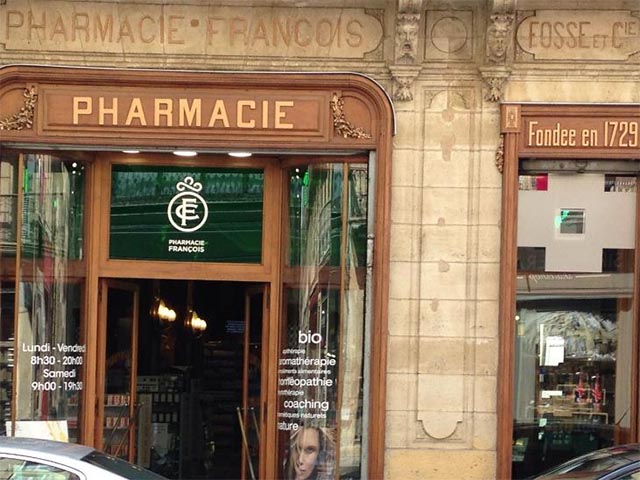 The invention of the chocolate suppository would be attributed to the Maison François. This pharmacy still exists at the corner of Cours Alsace-Lorraine and Rue du Pas-Saint-Georges in Bordeaux! For nearly 300 years, Bordeaux locals have been able to buy their medicines there!
The invention of the chocolate suppository would be attributed to the Maison François. This pharmacy still exists at the corner of Cours Alsace-Lorraine and Rue du Pas-Saint-Georges in Bordeaux! For nearly 300 years, Bordeaux locals have been able to buy their medicines there!
In 1729, when the Fosse family created this pharmacy shop, the Cours Alsace-Lorraine as we know it nowadays did not yet exist. The entrance was by the rue du Pas-Saint-Georges (you still can see the engraved stone lintel if you walk there). At the same time drugstore, apothecary and grocery store until the 20th century, the shop started to sell suppositories coated with cocoa butter melting at body temperature. As to whether the invention took place here??????
You won't find any more cocoa butter suppositories, nor Hepascol François on the shelves either: this medicine made from Macau artichoke leaves decoction was also invented by the Fosse family to relieve all kinds of liver disorders!
The wine bottle label, invented in Bordeaux
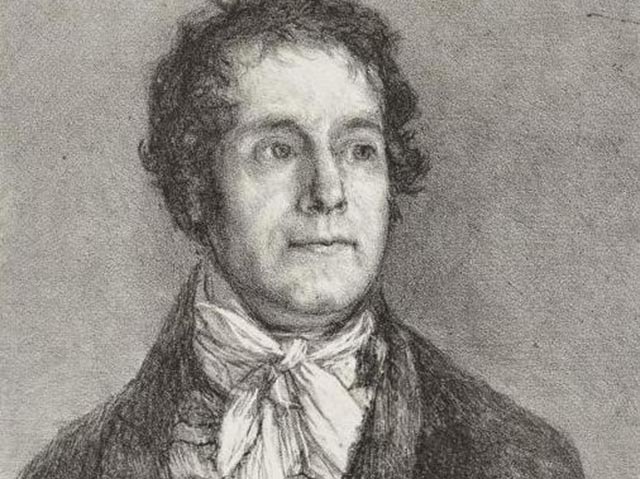 I'm sure you've already wondered if there was a person behind the wine label...Who had the bright idea to invent such a handy label?
I'm sure you've already wondered if there was a person behind the wine label...Who had the bright idea to invent such a handy label?
Of course, lithography was not invented in France but in Germany. But it is thanks to Cyprien Gaulon, a 19th century Bordeaux printer-lithographer, that the process had a wider field of application.
The technique of lithography had only just been invented in Germany about 15 years earlier, when Cyprien Gaulon, born on the island of St Domingue (Actual Haïti), came to live there in 1818 to open a printing house and teach writing. He was then 40 years old and immediately became passionate about this technique of graphic reproduction.
He became famous for the 4 bullfighting reproductions known as the Taureaux de Bordeaux, entrusted for the printing in 1825 by Goya; this collaboration was also the occasion for the Spanish artist to make, in addition to 3 other lithographs, the portrait of the printer. It is said that, given Goya's disastrous financial situation in his final years, he probably could not pay for it and, on the other hand, drew his portrait.
This former calligraphy professor developed this impressive art with the first wine labels (called 'vignettes' at the time). Cyprien Gaulon's former company was located at 60 rue Saint-Remi in Bordeaux.
Until then, the identification of vintages was done by various processes such as wax coating of the neck, coloured threads, moulding of the glass or even a simple paint mark on the bottle, etc... Cyprien Gaulon has revolutionized the authentication of the commercial origin of wines by a printing process revealing the origin of the Crus. All labels for wines, spirits, syrups and other liquids bottled throughout the world are the result of this invention!
The canned food open key to open sardine cans
The key to open the canned food and especially sardines was born in Camille-Jullian's place in today's Utopia cinema, well know by locals.
In the 19th century, the building housed the cannery of Charles Teyssonneau, a native of Gujan-Mestras who remained mayor of Tresses for more than a decade. His old house is a beautiful mansion in rue St Siméon recently restored and brought up to standard (2017).
The building of this former church available, it was acquired in 1863 by Charles Teysonneau who installed a vegetable and sardine canning plant there. This brand lasted for a long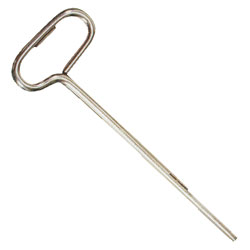 time and the Bordeaux seniors still may remember the extra-fine peas from Teyssonneau!
time and the Bordeaux seniors still may remember the extra-fine peas from Teyssonneau!
But in any case, it is there, in this former church of Saint Symeon, that Teyssonneau invented an ingenious instrument that was to conquer the world by being reproduced in millions of copies! It is nothing more than the key opening sardine tins, indispensable for more than a century to open cans of tinned sardines!
I guess than the yougest readers here have no idea about what I am talking about... Still a few years ago, a little piece of metal stuck out of the can; you put it in the little slot of the key at the bottom. You would turn it backwards and twist it all around can and it would remove the top. It was necessary to unfold a tab and then give 3 or 4 turns of key without letting your fingertips drag too close to the sharp edges! This tool, now outdated, tends to disappear, because nowadays, the lid of tins is pre-cut and fitted with a ring that allows you to pull to detach it from the body of the tin.
To go further...
The sardine oil cannery business was born in France, in Nantes and Bordeaux around the 1820s. It remained confidential for a long time until the invention of the autoclave in 1852 and then moved to an industrial stage.
But why Nantes and Bordeaux? In order to understand this implantation, we must mention the definitive prohibition of the slavery and the triangular trade. These two cities quickly understood the need to reinvent their activities: they had networks, financial resources and dynamic traders used to make business.
There is also a large ans rich hinterland rich producing cereals and vineyards. There is also a market beyond the seas or more simply on outgoing ships. Three main categories of food industries will successively emerge: sugar refineries, canneries and biscuit factories. It is in this context that entrepreneurs are trying their luck in areas that are little known on an industrial scale, such as biscuit factories and canneries. Thus we find Teyssonneau in Bordeaux who has been in charge of supplies for the Navy, among other things.
The Bordeaux mixture or Bouillie Bordelaise
Bordeaux mixture is a fungicide. It is a mixture of water, copper sulphate and lime.
Its copper base gives it a blue colour to the mixture. It is used on crops to eliminate fungus causing cryptogamic diseases. It is used by spraying it on the leaves and fruits of the vine, it is a preventive treatment against mildew.
Mildew is a mould that attacks the organs of the vine, especially the leaves and grapes. It was first observed in southwestern France in 1878, but scientists were unable to find a cure.
It was only by chance that a scientist, Alexis Millardet, found a solution... This Professor of Botany at the Faculty of Sciences in Bordeaux was astonished by the beautiful condition of the vines on the roadside during a trip to the Médoc area in 1882. They were the vines of Château Ducru-Beaucaillou in Saint-Julien-Beychevelle, owned by Nathaniel Johnston. The vine therefore owes them the famous "bouillie bordelaise", a coppery application that helps fight mildew!
Nota bene: as for the victory over phylloxera, this terrible insect that ravaged the vineyards in the 19th century, we owe it to Alexis Millardet who grafted the French grape varieties onto the American plants, which were resistant to the damned insect.
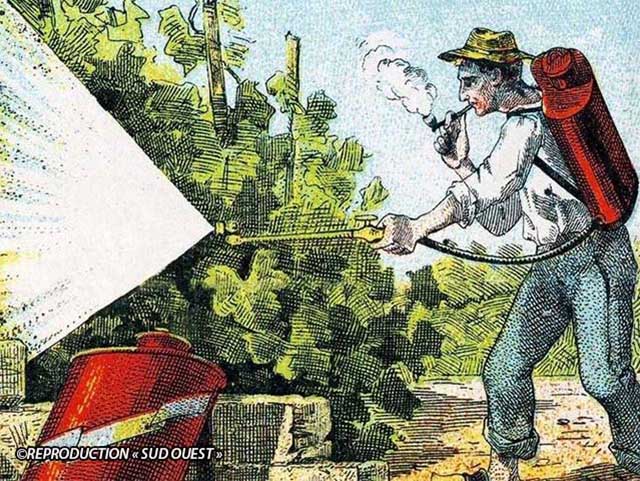
To go further...
Even if copper is the main fungicide authorized in organic farming, it does not only have beneficial effects on the soil.
Hobby gardeners have been using it for a long time as a powdered mixture to be diluted, called "bouillie bordelaise". Copper is very effective in treating vine and potatoes blight or apple rot. But the downside is that the systematic use of this substance causes soil pollution. Excessive copper destroys underground fungi, sprouts and earthworms that make up the life of the soil. By eliminating the actors in this natural process, copper thus contributes to soil impoverishment. In addition, when copper particles run off into waterways, they are toxic to fish and other aquatic organisms.
Today, Bordeaux celebrates Millardet with a elegant bust in the Public Garden and a street renamed after him in the district Tourny.
The modern bicycle invented in Bordeaux by Georges Juzan
Georges Juzan was then a bicycle manufacturer and repairer. He lived at 124 rue Fondaudège in Bordeaux.
We know the invention of the draisienne by the German Von Drais de Sauerbrun in 1818: a two-wheeled wooden bicycle. Later, pedals were added directly to the front wheel 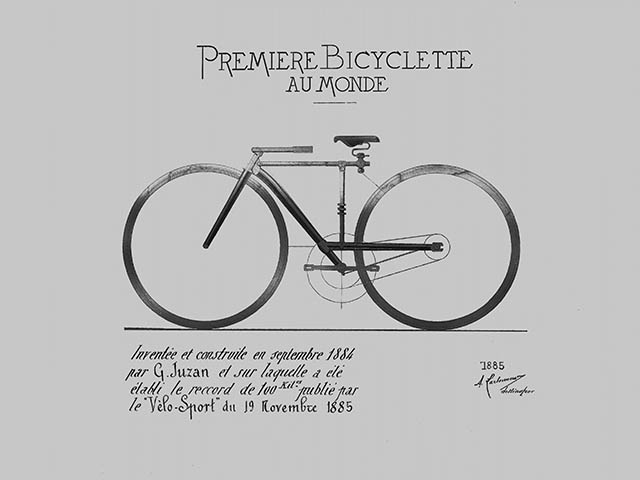 (1839).
(1839).
In the 1870s, an Englishman lightened the machine by using closer, metal and tensioned spokes for the wheels: the famous "Grand Bi" with its two unequal wheels.
It was a combination of circumstances and an Englishman to crash on the Place des Quinconces for an ingenious Bordeaux mechanic, Georges Juzan, to invent the modern bicycle!
This accident gave Juzan the idea to build a two-wheeled machine of equal diameter, a roller chain and an adjustable ball-bearing crankset. The first bicycle was built in his uncle's sewing machine and bicycle workshop, located in the chapel of the old hospital in rue de Bel-Orme.
Juzan named his new machine "bicycle".
For lack of money, the Bordeaux mechanic could not patent the modern bicycle and disappeared in total indifference.
Although it remains to be proven that Juzan is the inventor of the modern bicycle, he stays someone who has given a lot to the bicycle and its development, and this commitment deserves to be commended.
He will disappear at the age of 63 in a poverty without having patented his invention already spotted by the great bicycle brands: Rudge, Humbert, Gauthier in Saint-Etienne... Too bad!
Today, a street in Bordeaux still commerate Georges Juzan. It is located just after the peripheric boulevards, behind the main hospital Pellegrin.
Turf Rolls have been invented in Bordeaux !
Have you ever heard of Michel Chamoulaud? This man (died in 2018) filed a number of patents that allowed him to live on them for almost 40 years. Among his many creations, Michel Chamoulaud (originally from Merignac, near Bordeaux) is the creator of the roll lawn carpet, patented in 1976 under the trademark "Tapis minute". The success goes beyond the French borders : the product will be distributed in the United States, Sweden, Japan...
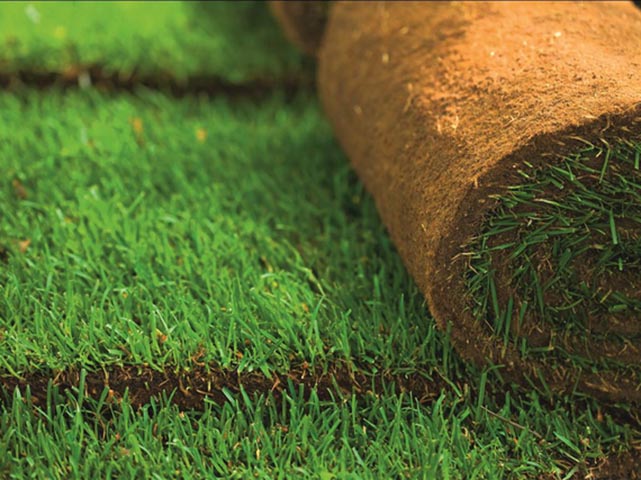 In the 80s, this arboriculturist, passionate about inventions, developed the roll turf, an invention sold all over the world, particularly for golf and football.
In the 80s, this arboriculturist, passionate about inventions, developed the roll turf, an invention sold all over the world, particularly for golf and football.
An invention that has a local source... the Landes forest! In 1974, he came up with the idea of using pine bark residues (belive me : a material that is abundant in the region!) to grow turf, whereas he was wondering how to use them. This growing set made from pine bark helps growth, makes the grass lighter, and makes it easy to roll and transport. When laid on plastic strips, the grass rolls up and down like a carpet.
Football clubs, rugby clubs, golf courses, all use this invention today for their turf.
The patent has since fallen into the public domain. Michel Chamoulaud continued his inventive activity, and broadened his concept, creating flower carpets, and a vertical garden system that he was able to market to local authorities for the ornamentation of public urban green spaces. In 2001, he filed a patent for the greening of walls and roofs, which required him to solve several problems, including the regulation of water supply to moisten the plants' root systems.
"Every person is good at something.
My job was to provide solutions.
techniques that meet needs. »
(Michel Chamoulaud)
Bordeaux engineer designs Iglou, an emergency shelter for the homeless
Designed by Geoffroy de Reynal, the Iglou is intended to provide better protection from the cold than a simple tent. This 26-year-old engineer from Bordeaux specialises in renewable energies.
In 2017, he invented the Iglou, a sort of waterproof rounded cabin made of polyethylene foam.
Intended for the homeless and the poorly housed, this white tunnel, two metres long, 1.20 metres wide and 1.20 metres high, offers protection against the cold thanks to the human warmth inside.
Once the end of the tunnel is closed, it ensures a temperature up to 15° degrees higher than outside. A ventilation system is integrated, as well as a small lamp, powered by solar energy. Easy to assemble, this shelter is fire resistant. In addition to insulating from the cold, it also provides people sleeping on the street with a better privacy than a simple tent.
The Bordeaux local branch of Médecins du Monde is conducting the first experiment beside him. He made the first ones on his balcony in the Victory district of Bordeaux. He received support from the company PSD in Saint-Jean d'Illac, a foam transformer company, and is accompanied by Médecins du Monde in Bordeaux and Action froid in Paris to reach homeless people who might be interested in.
To give your support to this great idea: www.Iglou.fr
Just for the anecdote... One last invention that could have been invented in Bordeaux but in fact it wasn't...
It's well talked about: the miracle pill that cures men! Viagra is an American invention.... But the scientist who developed it is a Frenchman, originally from Bordeaux and exiled in the United States! Our country is definitely letting its brains go !
Pierre-André Wicker, a graduate of the Faculty of Medecine in Bordeaux, played a leading role in the development of the famous blue pill.
After a brief career as a clinic manager in the south-west of France, Wicker left France for good in 1984 with his wife (daughter of a winegrower from the Bordeaux region) and his two children aged 8 and 6. There he joined his former training supervisor at the Cleveland Clinic in Ohio.
"I was head of the clinic at the Haut-l'Evêque hospital in Bordeaux,
but I was offered a more interesting position in America"
he said.
His interest in drug research led him to join Pfizer. The family moved to Connecticut in 1989, between Boston and New York. Five years later, he found himself working on what would become Viagra. He is the only French scientist to have participated in the development of Viagra, the little blue pill that has saved millions of men from erectile dysfunction since 1998.
Viagra represents 4 years of his life, from 1994 to 1998. The Frenchman then held one of the main roles at the head of the team in charge of clinical development in North America. This research probably be the most memorable of his career because never before had Pfizer or any pharmaceutical industry decided to invest so much time and personnel on the subject, but also because no one could ever have thought that it would help tens of millions of people in their most intimate suffering.
That is the end of my focus on Bordeaux inventions, please share this article if you liked it !
Thank you for reading 'til the end !
Feel free to join me on social networks to follow my tourist guide's adventures
and feel free to ask a free quote for your next Bordeaux guided tour !
Licensed Bordeaux tour guide, Bordeaux tourist guide, Bordeaux guided tours, Unusual Bordeaux Tours
Terms & Conditions
Report